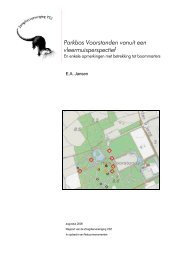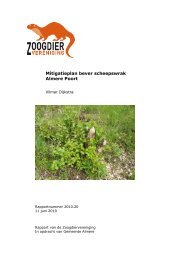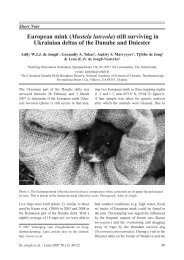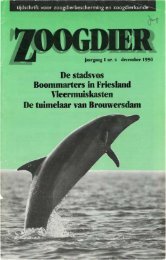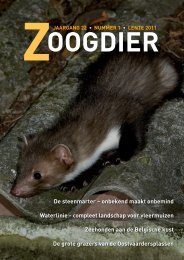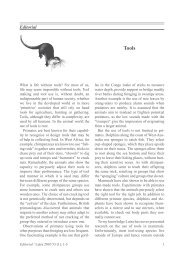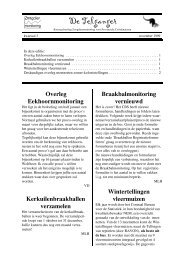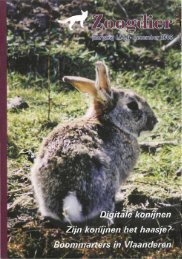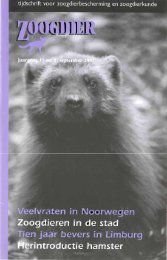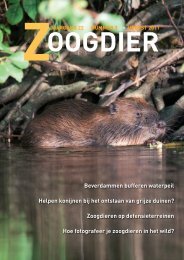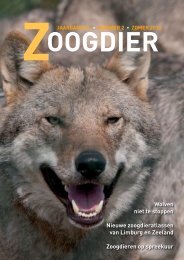binnenwerk 48-2-2005 - De Zoogdiervereniging
binnenwerk 48-2-2005 - De Zoogdiervereniging
binnenwerk 48-2-2005 - De Zoogdiervereniging
Create successful ePaper yourself
Turn your PDF publications into a flip-book with our unique Google optimized e-Paper software.
light coloured; the muzzle was white around themouth and the animal had a white bib; the blackdorsal stripe did not continue along the tail. Ahair sample was collected for DNA analysis (seebelow). The following external measurementswere taken, total length: at least 85 cm; head andbody length: 52.5 cm; tail length: 31 cm (includinghair: 33 cm); hind foot length: 13.8 cm (includingnails: 14.6 cm): ear length 60 mm (withhair: 68 mm); weight: 3700 g.In the course of <strong>2005</strong> it became clear that thiswas an unintentional introduction. The cat wasfound as a young stray in the summer of 2003 ina forest in the Vosges mountains (France) andwas taken away to Heeze (The Netherlands), inthe belief that it was a domestic cat. It prosperedin its new home in Heeze until disappearing oneday in the winter of 2004.DNA analysesTissue material from two cats, the ones fromGroenlanden and from Heeze was available forDNA analysis. These samples had been conservedin an ATL-buffer. DNA was extractedfrom these samples at Alterra Research Institute,using the DNeasy Tissue Kit, following the protocolof the manufacturer (Qiagen Inc.). Tongswere used to pulverize the sample taken from theroot channel of the Groenlanden cat in order toget better access to the DNA. A third sample ofDNA, from a domestic cat, was extracted for referencepurposes.Since the wildcat and domestic cat are closelyrelated, it is presently not easy to make a geneticallyclear distinction between them. However,we can analyse the DNA on microsatellites, becausethere are differences in the alleles and theirfrequencies. This requires access to a comprehensiveDNA collection, containing material ofmany wild and domestic cats, and preferably ofwildcats originating from close to the Netherlands.Since Alterra does not have such a database, we sent the samples for further analysis tothe Instituto Nationale per la Fauna Selvatica‘Lozano Emilia’ in Bologna, Italy (for moretechnical details see: Jansman et al. 2003, Leciset al. 2006). Their DNA collection includes samplesof wildcats from the Eifel hills.The genetic distance of each sample was measuredand the samples were assigned to the mostrelated genetic cluster, using the computer programmeSTRUCTURE (Pritchard et al. 2000).The outcomes of such an analysis with the materialof different cats should give two clusters,one with wildcat, the other with domestic cat.The overlap of the clusters illustrates the geneticresemblance and may be indicative of the presenceof hybrids. Although this technique doesnot provide 100% certainty on the identity of aspecimen, the degree of uncertainty is muchsmaller if the tested sample lies outside the overlaparea of both clusters.The reference sample of the domestic cat wasinside the domestic cat cluster and only bore a20% resemblance to the wildcat cluster. The hairsample taken from the cat from Heeze had a 90%fit with the wildcat cluster, providing us with anotherargument to identify this cat as a wildcat. Itwas not possible to obtain results from theGroenlanden cat, probably because the DNAmaterial was too degraded, owing to the methodof preservation that had been used.DiscussionThe occurrence of the wildcat in theNetherlandsBased on the intracranial volume of 40.0 cm 3 , thecat found at Groenlanden can be positively identifiedas a wildcat, even though failure of the DNAanalysis of the root channel sample means thatthis identification could not be confirmed genetically.As all the external characteristics of theVaalsbroek cat indicate a wildcat (see also: table1), we also consider this animal to be a wildcat.Although we cannot exclude the possibility thatthese two positive records are also cases of introduction,intentional or not, we think that this is unlikely.For example, Heike Weber (of NordhornZoo, Germany) informed us that there had been:“definitely no escapes from our zoo since 1990”.80 Canters et al. / Lutra <strong>2005</strong> <strong>48</strong> (2): 67-90



